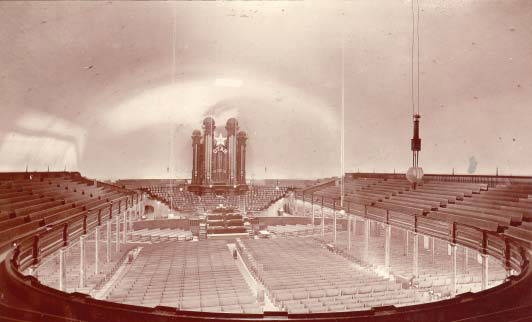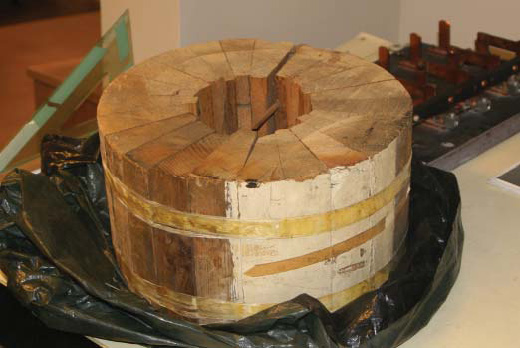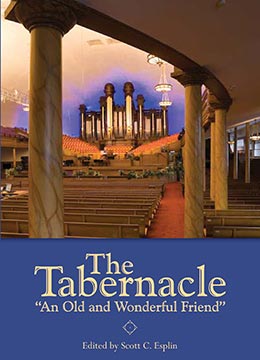The Gallery
Scott C. Esplin, “The Gallery,” in The Tabernacle: “An Old and Wonderful Friend” (Provo, UT: Religious Studies Center, Brigham Young University, 2007), 191–200.
At the time the Tabernacle was first occupied for October conference of 1867, temporary seats were used in a large portion of the hall, and many other details were not then completed. The permanent seats were installed as rapidly as possible throughout the winter of 1867–68 and were completed sometime during the summer of 1868, although no definite date of their completion is given.
There was no gallery in the building when it was first used. The unbroken arched roof presented a vastness that must have been impressive. At the time Truman O. Angell was designing the interior of the Tabernacle, he foresaw the possible need for a gallery and noted in his journal: “Friday, [September 27, 1867.] On work in time, I will note the President came to the New Tabernacle, and seemed to approve of the way I had and was closing up the east end. He expressed I had got all the windows that would be needed [for] the 6 spaces on the extreme east end. He asked if they were to be passages or doorways for the public. I told him yes. He said that [was] right, although only 2 of those are made doors now, the 4 others of the 6 will be used for a gallery when the need of one is wanted.”[1]
The actual construction of the gallery in the Tabernacle was started in the fall of 1869,[2] although no definite date is available. It was still under construction at the time April conference of 1870 was to be held. Because the gallery was in an uncompleted state and also because President Young was absent from Salt Lake City on a tour of Southern Utah, the conference was convened for part of one day and then adjourned until May 5, 1870. The adjournment was decided in advance and announced in the April 5 issue of the Deseret Evening News:
Tomorrow, the 6th of April, 1870, is the commencement of the Fortieth Annual Conference of the Church of Jesus Christ of Latter-day Saints. In the morning at 10 o’clock the Saints will convene in the Tabernacle, and hold one meeting, when the Conference will adjourn until the 5th of May. This has been deemed the wiser course, owing to the absence, in the southern portion of the Territory, of Presidents Young and Smith; and also on account of the unfinished state of the gallery in the New Tabernacle. By the 5th of next month it is believed that the new gallery will be so far finished as to be ready for use by the public, and twelve thousand persons may then be comfortably seated within the walls of the spacious building. Under such circumstances it is presumed that Conference may be held in comfort, and that none who desire to attend will be under the necessity of staying away, for lack of comfortable accommodation, as has been the case on many occasions in the past.[3]
Brigham Young commented on the incident in a letter he wrote to Albert Carrington, April 23, 1870. This was written after his return from the trip south: “The April conference, as you are aware had been contemplated for some time, was adjourned until the 5th May, in consequence of the gallery in the new Tabernacle not being completed, as well as on account of our absence south.”[4]
The author has been unable to locate any direct proof that would indicate who designed the gallery. However, it appears that the work was done by Truman O. Angell. He was still architect of The Church of Jesus Christ of Latter-day Saints, and since he had designed the interior of the Tabernacle it is logical to assume that he also designed the gallery.
The design of the gallery is most pleasing and is a rather remarkable piece of work. Not only did it provide three thousand extra seats, but it added beauty to the interior of the building; and most important, it greatly improved the acoustics of the Tabernacle. The contribution to the improvement of the acoustics is significant, for the acoustical properties of the Tabernacle have been one of its main sources of fame. The Deseret Evening News editor apparently felt that the completion of the gallery was of considerable significance, for he treated it at length:
The addition which has been made to the New Tabernacle by the construction of the gallery, has effected a great change in the appearance of that remarkable structure. To our eye the gallery has the effect to lessen the vastness of the building and to diminish the apparent hight of the ceiling. But it gives a completeness and finish to it that we admire. Standing at the Eastern end of the gallery, the building loses none of its immensity by the erection of this addition, on the contrary, we think a better idea of its proportions is obtained from that point than before. The general opinion is that the construction of the gallery will improve the acoustic qualities of the house, and that the congregation will hear distinctly in every seat; but should this not be the case, there are other improvements, which time did not permit to be made before conference, that will correct any defects of this kind that may still exist. We venture the opinion that, before it is finished, its acoustic properties will be superior to those of any large building in the United States, as it already is the largest auditorium of which we have any knowledge.
The gallery measures in front, from one end to the other, 395 feet. At the back it is probably about 500 feet. It is about thirty-two feet in depth. It is supported by seventy-two columns. There are six stairways—two north, two east and two south. The seats at the present will be mostly temporary, there not being sufficient time to construct the others before Conference. The gallery will seat 3,000 persons, which will afford, in the entire building, sitting accommodation for 11,000, and standing room, in addition, for between 2,000 and 3,000, making the total capacity of the building between 13,000 and 14,000!—clearly exhibiting what a united people can accomplish under wise guidance. Steps will be taken to select a corps of door keepers, and deacons to seat the congregation. In the body of the building the people will be seated as formerly; that is, the ladies in the centre seats and the gentlemen on the side seats. In the gallery, the ladies will occupy the north and the gentlemen the south side. Those who take seats in that part are requested to observe this regulation.
It is the intention to have the New Tabernacle thrown open for worship at 2 p.m. on Sunday next, and it is hoped that there will be a large attendance. A small congregation would almost be lost there; besides, it will offer a good opportunity, before holding Conference, to ascertain whether the addition of a gallery has corrected any defects in sound that formerly existed.
On Thursday next, the 5th of May, the adjourned Annual Conference will convene at 10 o’clock a.m. in the New Tabernacle. It is anticipated there will be a large attendance of people on that occasion. We scarcely think there need be any fear entertained of lack of room, though there never was a time in the history of the Latter-day Saints—no matter how large the building might be which they had to meet in—when the people could find sufficient room to hold their conferences. It would be a grand and very pleasing sight to see the New Tabernacle filled to its utmost capacity.[5]
The meeting that was scheduled prior to the opening of conference was well attended, and as hoped, the addition of the gallery was definitely advantageous from the standpoint of the acoustics. The report of the meeting is interesting:
There was an immense gathering yesterday afternoon at the New Tabernacle. The weather was delightful, and must have been tempting even to invalids to venture out. One hour before the time appointed we saw persons wending their way with the evident design of securing good seats. The gallery seemed to be the most desirable place, as it was well filled some time before the commencement of the meeting. Looking at the size of the congregation and the vastness of the building it would seem to be very difficult if not impossible to make all hear. Yet from inquiries we have made, there were few, if any, who failed to hear President Young during his entire remarks yesterday afternoon. President Smith was not heard so well from some points at the commencement of his remarks; but, as he warmed up, he was heard distinctly. While Elder Bywater was speaking there was not the same quiet maintained that had been, and it was not possible in some parts of the building to keep the run of what he said.
While President Young was addressing the congregation his hearers kept very still, and we are informed by persons who sat on the seats where they were accustomed to sit last Summer, that yesterday they heard as they never did before. The gallery had made, judging by their experience, a great improvement in the acoustic qualities of the building. The reverberation that was noticed on every previous occasion when meeting was held there, did not exist yesterday, and though there may be even now some particular parts of the house where a speaker cannot be heard very distinctly, still, from all we can learn, the congregation in every part can now hear more plainly than before.
We trust that strict measures will be taken by the deacons and doorkeepers to prevent the walking about of children and others during the services. The moving backward and forward of young people yesterday was very annoying, and must have materially interfered with the hearing of those in whose neighborhood they walked. In a building like the New Tabernacle strict order should be enforced, or the words of the loudest speakers will be lost to a large portion of the congregation, and the enjoyment of the remainder will be seriously marred. Another point: It is a great convenience on a hot day, when meeting has been held for some time, to get a drink of cool water; and children, especially, get very restless if they cannot quench their thirst. But the practice of carrying water around can be made objectionable by the excess of zeal which those entrusted with this duty sometimes manifest. They can, if they choose, lessen the interest felt in the meeting and disturb the congregation by their officiousness; this would be a greater injury than the water which they pass around is a benefit. But on these points experience will suggest the best course to pursue.
The community is fortunate in having so cool and commodious a place of worship as is the New Tabernacle. It is a building of which, as well as the organ, we may be proud, and when the improvements yet contemplated shall have been made, we think it will be an easy labor for a speaker to make himself heard by the congregation that shall assemble within its walls.[6]
The gallery was in use at the postponed conference, and its additional seating capacity, as well as the improved acoustics of the building, were much appreciated.
Even with the addition of the gallery there remained much work to be done. The seats had to be finished for the gallery, and other refinements had to be made. This “finishing” of the Tabernacle must have gone on for a considerable time, for it was not dedicated until October of 1875. Dedication of Mormon buildings is usually done at the time of their completion. If this general rule applied to the Tabernacle, it could be said that this building was not completely finished until its dedication in 1875. The minutes of the dedicatory service follow:
The Forty Sixth Semi-annual conference of the Church of Jesus Christ of Latter Day Saints convened this morning, in the New Tabernacle, October 6th, 1875, at 10 o’clock. . . .
Conference was called to order by Prest. B. Young.
The Choir sang—
My God, the spring of all my joys, the life of my delights.
Prayer by Prest. Joseph Young.
The choir sung—
Praise ye the Lord, my heart shall join,
In work so pleasant, so divine.
President Brigham Young.
We purpose at this Conference to dedicate this Tabernacle; the dedication prayer will be read on Saturday morning. . . .[7]
Saturday, 10 a.m., Oct. 9.
The choir sang—
Great God indulge my humble claim:
Thou art my hope, my joy, my rest.
Prayer by Elder C. C. Rich.
The choir sang—
This house we dedicate to thee,
Our God, our fathers’ God.
President Brigham Young said Elder John Taylor would now offer the dedicatory prayer.[8]
Elder Taylor’s prayer was lengthy and blessed the workmen who had constructed the building, dedicated the building unto the uses of righteousness, and blessed those who entered there for worship that they might have the proper spirit. The full text of the prayer was printed in the October 9, 1870, issue of the Deseret Evening News. The dedicatory services completed the efforts of the many who had worked to construct the Tabernacle. The application of inventiveness, industriousness, and perseverance had resulted in a notable triumph for the Mormon pioneers.

The gallery added seating for three thousand more people and improved the acoustics by impeding echoes and reverberations.

Cross section model of a gallery column. The pillars that hold up the gallery were constructed from wood but made to look like stone. Tall sections of pine were cut into wedges and bound together, forming a straight, hollow pillar. The columns were then sanded and painted to resemble fine marble.
Notes
[1] Angell Journal, September 27, 1867.
[2] Journal History, August 21, 1869.
[3] “Fortieth Annual Conference,” Deseret Evening News, April 5, 1870.
[4] “Correspondence,” Millennial Star, May 24, 1870, 330.
[5] “The New Tabernacle,” Deseret Evening News, April 28, 1870.
[6] “The New Tabernacle Yesterday,” Deseret Evening News, May 2, 1870.
[7] “Semiannual Conference,” Deseret Evening News, October 6, 1870.
[8] “Semiannual Conference,” Deseret Evening News, October 9, 1870.
